The adornment of silence
secrecy and symbolic power in American freemasonry
by Hugh B. Urban
Ohio State University
Introduction
The secret operates as an adorning possession. . . . This
involves the contradiction that what recedes before the consciousness of . . .
others and is hidden from them is emphasized in their consciousness; that one
should appear as a noteworthy person through what one conceals (Simmel: 337).
I will always hail, ever conceal, and never reveal (Pike 1871: 63).
[1] It is surely one of the most striking paradoxes
in the history of American religion that the period of the late nineteenth
century - the same period which witnessed an intense acceleration of
technological progress, social and economic growth, industrialization and
urbanization - also witnessed the greatest flowering of the esoteric rituals and
secret traditions of Freemasonry. This was an era permeated by what some have
called a "general mania" of clubs, fraternal organizations, secret societies,
and above all the Masonic Lodge. In the years between 1879 and 1925, in fact,
membership in the Lodges suddenly rose from 550,000 to over three million (Dumenil:
xii; Kauffman: 8f; Clawson). Even as the mainstream Protestant churches were
attempting to address the problems of an increasingly urbanized, industrialized,
and multi-racial society, the Lodges were attracting white, middle class native
males in unprecedented numbers. The widespread presence of the Masonic lodges in
the late nineteenth century, and above all, the popularity of the most esoteric
Lodges like the Scottish Rite, present us with a series of apparent
contradictions: an ideal of democracy and liberty side by side with elitism and
authoritarianism; and a rhetoric of brotherhood and universal humanity side by
side with elaborate hierarchies of exclusion (Carnes 1989; Dumenil).
 |
|
Figure 1
Albert Pike as Grand Commander, ca. 1875 (Fox) |
[2] Known as the "Moses" of American Freemasonry,
Albert Pike (figure 1) stands out as perhaps the clearest single embodiment of
the series of paradoxes which pervade the nineteenth century Lodge. A man of
remarkable boldness and tremendous egotism, Pike was, in his youth, one of the
greatest adventurers in the American Southwest. In his maturity, he served as
Brigadier General in the Confederate Forces during the Civil War. Yet after
losing his entire fortune and reputation due to a humiliating scandal, Pike
retired into the esoteric traditions of Scottish Rite Masonry. If he had lost
his previous economic wealth and status, it would seem that he recovered a new
kind of status, power and prestige as the greatest scholar of the Scottish Rite
and the most respected authority on the innermost secrets and highest degrees of
the Brotherhood.
[3] Various scholars have offered possible
interpretations for the enigmatic role of American Freemasonry. As early as
Toqueville, for example, it was suggested that the obsession with secret
fraternities was the consequence of a democratic society without fixed
hierarchies: "In a nation devoid of established hierarchies and traditional
protections, the citizens sought strength through association" (129; cf.
Kauffman: 8). Others like Mervyn Jones and Brian Greenberg have pointed to the
role the Lodges played in late nineteenth century business and capitalism, as a
kind of "unofficial guild of businessmen" amidst modern industrialized society
(Jones: 177). And still others like Lynn Dumenil argue for the sociological
function of American Masonry, which served as a spiritual oasis in a rapidly
changing and increasingly heterogeneous world. By separating men from the
outside world, placing them securely amongst the brothers of the lodge, the
Lodge reinforced the traditional values of middle-class white Protestant men (Dumenil:
32-42; cf. Clawson 1984: 6ff).
[4] Unfortunately, although Dumenil and others have
provided useful insights into the social role of Masonry, few have made serious
efforts to understand the enormous role of secrecy, occult symbolism and ritual
in the Lodges. In other words, why did these middle class men take such delight
in arcane secrets and esoteric ceremonies, rather than joining a more secular
fraternal group? One of the few scholars to examine the role of secret ritual in
the Lodges is Mark Carnes, who combines psychological and sociological theory to
look at gender symbolism in Masonic initiation. During a period in which
mainline Protestant churches were increasingly dominated by women, he argues,
the secret initiation of the Lodge offered a means of achieving the difficult
transition from the feminine world of domesticity to the masculine world of the
workplace. The aim of fraternal ritual was, in short, to "provide solace and
psychological guidance during young men's passage to manhood in Victorian
America" (1989: 14; cf.1996: 72f).
[5] While not denying the value of each of these
interpretations on a limited level, I will suggest a new approach to the problem
of nineteenth century Masonry, and more importantly, to the problem of secrecy
in the history of religions as a whole. Secrecy, I will argue, is best
understood not in terms of its substance or content, but rather in terms of its
form and the ways in which secrets are concealed and exchanged.
Here I will adapt and modify some of the early insights of Georg Simmel, and his
key notion of secrecy as an "adorning possession." Rather than a simple
mask for some alleged hidden content, secrecy, Simmel argues, is a sociological
form which adorns the owner of concealed knowledge with the mark of social
distinction or status. Like fine clothing or jewelry, secrecy simultaneously
conceals even as it reveals, at once hiding certain aspects of its
wearer from view and surrounding him with an aura of mystery, awe and power
(337ff). Secrecy thus functions much like Pierre Bourdieu's notion of "symbolic
capital" - as a rare, scarce resource or valuable commodity, which confers a
special kind of prestige and so determines one's status within a given hierarchy
of power (1977a, 1981).
[6] It is precisely this kind of adornment or
capital, I submit, that attracted Pike and so many others to the arcane
mysteries of the Lodge. Although Masonry, like other esoteric organizations, has
frequently been attacked as a subversive, rebellious, or "counter-cultural"
phenomenon (Tiryakian; Roszak), more recent scholarship has shown that the
Lodges were predominantly conservative, respectable, and elitist organizations.
In contrast to many working class fraternal groups, the Masonic orders
reinforced traditional values, conferred status and cemented business relations,
primarily among white, native, middle and upper class males (Dumenil: 89ff). As
I will argue, Pike and others turned to the secret mysteries of the Lodge in
large part as a means of reinforcing their own symbolic capital. It helped these
white males to maintain their traditional status amidst the rapidly changing
world of post-Civil War America, in the face of tremendous economic growth,
racial integration, feminism, and other forces which threatened their long held
privileges. Masonry offered a means of preserving the cherished American ideals
of democracy and freedom, while at the same time maintaining a clear form of
elitism and exclusivism. At the same time that it constructed an elaborate
hierarchy of advancements, ostensibly based on "merit" and moral goodness, it
also masked and re-coded deeper differences of wealth, class, sex, and race.
[7] After a theoretical discussion of the problem of
secrecy, I will recount Pike's life and his role in late nineteenth century
Masonry. I will then examine three main strategies employed by Pike and his
fellow Masons in their quest for symbolic capital: first, the creation of a new
social space, which is ostensibly based on egalitarianism and meritocracy, but
which in fact reproduces the status of a small elite; second, the preoccupation
with esoteric symbolism, which creates a body of rare and valuable knowledge
that can be exchanged as a source of symbolic capital; and third, the
construction of an elaborate hierarchy of degrees, which offers a ladder of
upward mobility and ever-increasing "distinction."
The Adornment of Silence: Secrecy and Symbolic Capital
Among children, pride and bragging are often based on a child's
being able to say to the other: I know something you don't know...This jealousy
of the knowledge about facts hidden to others is sown in all contexts from the
smallest to the largest. . . . The secret gives one a position of exception. . .
. All superior persons . . . have something mysterious. From secrecy . . . grows
the error according to which everything mysterious is something important and
essential (Simmel: 332-33).
All men desire distinction, and feel the need of some ennobling
object in life (Pike 1871: 349).
[8] The past several years have witnessed a
remarkable proliferation of interest in the topics of secrecy and esotericism.
Not only in a variety of academic disciplines, but also in popular
entertainment, cinema, media, or novels such as Foucault's Pendulum (and
even, now, on the Internet), there appears to be a growing
fascination with the tantalizing regions of the unknown and the occult. Yet
perhaps rather fittingly, despite this growing interest in the topic, the
subject of secrecy remains poorly understood and theoretically confused in the
academic community. Among historians of religions, such as Mircea Eliade and
Kees Bolle, the study of secrecy has remained disappointingly general,
universalistic and largely divorced from social and historical context. Even
Antoine Faivre's extensive work on Western esotericism takes virtually no
account of the very real social and political contexts in which esoteric
traditions emerge, and within which they are inextricably intertwined (see Urban
1998, in press).
[9] This is not the place to enter into a full
discussion of all the various theoretical approaches - sociological,
psychological, political, literary, etc. - that have been applied to the study
of secrecy. Here I will trust the lead of Beryl Bellman, T.M. Luhrmann, and
others who have critically evaluated the diverse approaches, pointing out the
problems and weaknesses of each. As Bellman suggests, most past sociological
approaches have been hampered by a persistent problem: namely, to define
"secrecy" primarily in terms of a hidden "content", and then to construct
various typologies based on the kind of content or on the effects of revealing
secrets (1-2). Even as early as 1906, Simmel's classic study had pointed out the
crucial distinction between the form and the content of secrecy:
for secrecy is a "sociological form that stands in neutrality above the value
functions of its contents" (331). Yet, Bellman argues, most studies of secrecy
have ignored this distinction, and have instead remained satisfied with
classifying the various contents or effects of secret information. On the one
hand, scholars as diverse as Norman MacKenzie, E.J. Howsbawm, or Mak Lou Fong,
have generated a wide variety of different, often conflicting, typological
schemes based on the content of secrecy. On the other hand, there are those like
Edward Shils, in his classic study of McCarthyism and the dread of Communism,
who have examined the effects of exposing concealed information (22ff). However,
neither of these approaches has proven particularly useful in understanding the
more concrete role of secrecy in social relations; instead, Bellman suggests,
they have contributed to a general confusion in the academic study of secrecy
(1; see Urban 1998, in press).
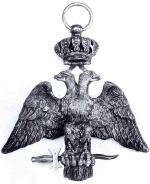 |
|
Figure 2
Scottish Rite Double-headed Eagle (Fox) |
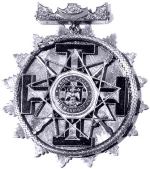 |
|
Figure 3
Scottish Rite Jewel Belonging to Albert Pike (Fox) |
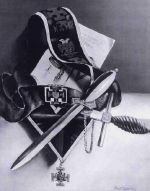 |
|
Figure 4
Regalia of the 31st Degree (Fox) |
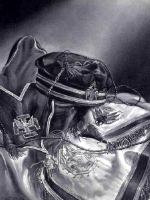 |
|
Figure 5
Regalia of the 32nd Degree (Fox) |
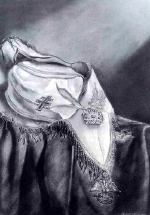 |
|
Figure 6
Regalia of the 33rd Degree (Fox) |
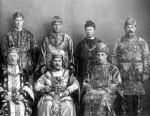 |
|
Figure 7
Costumed Scottish Rite Degree Team (Fox) |
[10] For my own part, I wish to suggest a new
approach to the problem of secrecy by returning to some of Simmel's original
insights and combining them with more recent insights of Bourdieu and Michel
Foucault: it is more fruitful, I submit, to turn the focus of our analysis away
from the content of secrecy and instead toward the forms and the
strategies through which secret information is concealed, revealed, and
exchanged. Here I wish to undertake a "theoretical shift," similar to the series
of shifts undertaken by Foucault in his study of power and sexuality. In his
investigation of the question of power, Foucault realized that he needed to turn
from the study of "power" as an oppressive, substantial force, imposed from the
"top down "in the political hierarchy, to a study of the strategies
through which power is manifested. Power thus appears as a far more subtle,
complex, and plural phenomenon, as a productive rather than an oppressive force,
which is radiated from multiple points at all levels of the social organism. So
too, I would suggest that we undertake a theoretical shift away from the
"secret" as simply a hidden content, and instead investigate the strategies or
"games of truth," through which the complex "effect" of secrecy is constructed.
That is to say, how is a given body of information endowed with the mystery,
awe, power, and prized value of a "secret?" Under what circumstances, in what
contexts, and through what relations of power is it exchanged? How does
possession of that secret information affect the status and prestige of the "one
who knows"? As Bellman has similarly argued in his work on the Poro society of
Liberia:
[S]ecrets cannot be characterized either by the contents of the
concealed message or by the consequences . . . they are understood by the way
concealed information is withheld, restricted . . . and exposed. The practice of
secrecy involves a do-not-talk-it proscription . . . that is contradicted by the
fact that secrecy is . . . a sociological form . . . constituted by the very
procedures whereby secrets are communicated (144; cf. Tefft: 321).
[11] As I wish to define it, secrecy is best
understood as a social form, a strategy aimed at the effect of "adornment." The
concept of secrecy as adornment, I submit, remains one of the most provocative,
most useful, and also hitherto most ignored aspects of Georg Simmel's classic
early study on secrecy, and one in most need of further development. As I wish
to define it, secrecy or the controlled circulation of valued information serves
to transform knowledge into something rare, a scare resource. Like precious
jewelry (figures 2 and 3) or expensive clothing (figures 4, 5, 6, and 7), it is
a covering, something which conceals or obscures aspects of the
physical person; but it is also an ornament, something which accentuates
the person, and so serves as a mark of distinction and prestige. The secret,
like a piece of fine jewelry or clothing, "radiates" a kind of aura of good
taste, honor, and status which also masks the more real material and economic
basis of its existence:
Adornment intensifies or enlarges the impression of the
personality by operating as a sort of radiation emanating from it. . . . The
radiations of adornment, the sensuous attention it provokes, supply the
personality with such an enlargement of its sphere: the personality, so to speak
is more when it is adorned (339-40).
[I]n the adorned body we possess more; if we have the adorned
body at our disposal, we are masters over more and nobler things. . . .
Bodily adornment becomes private property above all: it expands the ego and
enlarges the sphere around us . . . which consists in the pleasure and the
attention of our environment (344, my emphasis).
Adornment is thus a critical part of the larger process of social
transformation: it is that mystifying process which turns ordinary material
wealth (the possession of jewelry or clothing) into social wealth (the
possession of prestige, dignity or respect): "Adornment is the means by which
social power is transformed into visible, personal excellence" (343). So too,
the "adornment of silence" that we find in secrecy likewise serves to transform
the possession of certain valued knowledge into the possession of status and
superiority.
[12] Here I would like to combine Simmel's early
notion of secrecy as adornment with Pierre Bourdieu's more recent concept of
symbolic capital (1986; cf. Calhoun). Extending Marx's definition of the term,
Bourdieu defines capital as including not only economic wealth, but also the
nonmaterial resources of status, prestige, valued knowledge, and privileged
relationships. It refers in short to "all goods, material and symbolic that
present themselves as rare and worthy of being sought after in a
particular social formation" (1977a: 178; cf. 1981: 118-19). Like economic
capital, however, symbolic capital is not mere wealth which is simply hoarded
and stockpiled; rather, it is a self-reproducing form of wealth - a kind
of "accumulated labor," which gives its owner a form of "credit," or the ability
to appropriate the labor and products of other agents (1986: 252ff). Symbolic
capital is itself the product of a kind of "social alchemy," a process of
misrecognition, through which mere economic capital is transformed and
legitimated in the form of status, class, or distinction. This is the process at
work, for example, in the purchase of an expensive work of art, which confers
the mark of taste upon its owner, or in the investment in a good education,
which bestows cultivation and "cultural capital." As such, the dynamics of the
social field are determined largely by the strategies and maneuvers of agents in
their ongoing competition for these symbolic resources:
Symbolic capital is the product of a struggle in which each
agent is both a ruthless competitor and supreme judge. . . . This capital can
only be defended by means of a permanent struggle to keep up with the group
immediately above . . . and to distinguish oneself from the group below (1981:
123).
[13] In the context of an esoteric organization, two
processes are at work that serve to transform secret knowledge into a kind of
capital. First, the practice of secrecy and the strict guarding of information
transforms knowledge into a scare resource, a good that is "rare and worthy of
being sought after." To use Bourdieu's terms, secrecy involves an extreme form
of the "censorship" which is imposed on all statements within the "market of
symbolic goods." For every individual censors his or her expressions in
anticipation of their reception by the other members of the social field (1977b;
1984: 77). Secrecy, however, is an extreme form of self-censorship - a
deliberate, self-imposed censorship - that occurs in a very specific linguistic
market. Its function is to maximize the scarcity, value, and desirability of a
given piece of knowledge. For "if you seek to create highly valued
information . . . you must arrange worship so that few persons gain access to
these truths" (Barth: 217). Likewise as Luhrmann comments:
Secrecy is about control. It is about the individual possession
of knowledge that others do not have. . . . Secrecy elevates the value of the
thing concealed. That which is hidden grows desirable and seems powerful (161).
All knowledge is a form of property in that it can be
possessed. Knowledge can be given, acquired, even sold . . . like the difference
between private and public property, it is secret knowledge that evokes the
sense of possession most clearly (137).
[14] As Lamont Lindstrom has suggested in his work
on the peoples of Tanna in the South Pacific, secrecy is a central part of the
"conversational economy" which constitutes every social order. The practice of
secrecy serves to transform certain information into something that can be
owned, exchanged, accumulated - "a commodity, something that can be bought and
sold" (xii-xiii). As such, what is important about secrets is not the hidden
meanings they profess to contain, but rather, the complex "economy of exchanges"
or the resale value which secrets have as a commodity of knowledge and power
within a given "information market":
Secrets turn knowledge into property that can be exchanged.
People...swap or sell their secrets and/or their knowledge copyrights for . . .
money and other goods. Marketable information of this sort includes, spells,
medicines, songs, metaphorical words with new meaning. . . . By preserving
pattern of ignorance within the information market, secrecy fuels talk between
people who do not know and those who do (119).
[15] Secondly, once it has been converted into this
kind of scarce resource or valuable commodity, secret knowledge can serve as a
source of "symbolic capital" in Bourdieu's sense of the term, as a form of
status and power which can be accumulated by social actors, and which is
recognized as "legitimate" by others within a given social field. As Simmel
himself had long ago pointed out, "The secret gives one a position of
exception. . . . [A]ll superior persons have something mysterious" (337).
Secret knowledge thereby functions both as a form of both "cultural capital" -
that is, as special information or "legitimate knowledge", which purports to be
the key to inner gnosis - and as a form of "social capital" - that is, a sign of
membership within a specific community, and of hierarchical relationships with
significant others (e.g. between the master who holds esoteric knowledge and the
initiate to whom it is given). Particularly when combined with a series
initiations or a hierarchy of grades, this is, like all capital, a
self-reproducing form of wealth, which grows increasingly more profound and
powerful as one advances in the ranks of esoteric knowledge and ritual degrees.
[16] However, in distinction to most of the forms of
"capital" which Bourdieu discusses, the symbolic goods of the secret society can
only be exchanged behind closed doors, in the esoteric realm of ritual. Secret
knowledge is not valued and exchanged publicly in mainstream society or in the
field of exoteric relations, but solely within the field of the esoteric
society. Hence we might even call it a kind of "black market symbolic capital,"
a form of capital which is valued only in special circumstances outside of
ordinary social transactions. Indeed, in some cases, this knowledge may even be
considered dangerous, threatening, or illegal in the eyes of mainstream society.
This danger, however, only makes it all the more powerful, valuable, and
desirable.
[17] As such, the strategy of secrecy may be
employed for a variety of different social interests. It may be used by the
ruling elite to reinforce a particular social arrangement or hierarchy of power,
but it may also be used by subordinate and marginalized groups to subvert,
challenge, or undermine such hierarchies. In Foucault's words, "silence and
secrecy are a shelter for power, anchoring its prohibitions; but they also
loosen its hold and provide for areas of tolerance" (1978: 101). Unfortunately,
most past literature on secrecy has tended to exaggerate its revolutionary,
subversive, anti-establishment potential (Tiryakian; Hobsbawm). I shall argue,
on the contrary, that secrecy is very often, perhaps even more commonly,
employed by the ruling elites and powerful aristocracies. Tactics of secrecy
very often "work within an established body of tradition which is designed,
not to disrupt order and conformity, but to reinforce it" (Davis: 284).<12>
In Bourdieu's terms, the mystery surrounding secret knowledge is a powerful
expression of that "social alchemy" - that mystification and misrecognition,
which transforms the arbitrary arrangements of society and asymmetrical
relations of power into something that appears "legitimate" or even "natural"
(1977a: 171-97).
The Moses of American Freemasonry: The Life and Works of Albert Pike
The disenfranchised people of the South, robbed of all the
guarantees of the Constitution . . . can find no protection for property,
liberty or life except in secret association (Pike in W. Brown 1997: 440).
[18] Albert Pike (figure 1) stands out as a striking
example of the role of secrecy and esoteric knowledge as a source of symbolic
power. Famed in his youth as an adventurer and "one of the most remarkable
characters in the annals of the Southwest," Pike was revered in his later years
as the greatest authority on Masonry and the foremost proponent of the esoteric
traditions of the Scottish Rite (W. Brown 1997: 417ff; Fox: 89ff). Born in
Boston in 1809, the son of an irreverent, alcoholic cobbler and an extremely
pious, puritanical mother, he was from his youth a man of striking extremes and
contradictions. Although he attended Harvard in 1821, he was soon forced to
leave when he was unable to pay his tuition. Hence, he decided in 1824 to ignore
his mother's wish that he become a minister in order to live an adventurer's
life in the Southwest: he rode on wagon trains , survived snow storms, nearly
froze to death, and fought Indians, all the while exulting in these hardships,
for "he longed to share in the unconstrained life of the noble savage" (Carnes
1989: 136). He was known, moreover, for his wild parties, his skill in seducing
women, and for his tremendous physical and sexual appetites (he is said to have
weighed over 300 pounds in full manhood).
Torn by extremes represented by his irreverent father and pious
mother, Pike initially pursued a quest for manly assertion reflected in frontier
adventures, the pursuit of wealth and military glory, gastronomic and sexual
excess (Carnes 1989: 138).
[19] In 1831, Pike returned to the East, where he
studied law and was admitted to the Bar in 1836. Famed for his heroism in the
Southwest, Pike quickly built up a new reputation among the wealthy society of
Little Rock where he was extremely active and respected in the law, journalism,
and the politics of the day. However, the real turning point in his life did not
occur until he entered the Confederate army during the Civil War, where he held
the rank of Brigadier General, and was placed in command of the Indian
regiments. Pike suddenly became the center of an enormous scandal when the
Indians under his charge killed and mutilated the bodies of the Union soldiers.
At the war's end, Pike was blamed for the incident - by both Union and
Confederate sides - and denounced as the most malevolent of rebels, charged with
disobeying commands and inciting the Indians to revolt. His former wealth and
property were confiscated, and along with them his former status and prestige.
Fleeing civilized humanity, Pike withdrew into the hills of Arkansas and lived
as a hermit in the wilderness. It was not until 1869 that he was publicly
pardoned and allowed to return to society (W. Brown 1997: 443ff).
[20] One of the most controversial and troubling
questions in Pike's life is his possible involvement in another infamous secret
brotherhood which also emerged in the South during the post-war years - the Ku
Klux Klan - and the possible links between the Scottish Rite and the secret
rituals of the Klan. Indeed, many critics have long charged Pike as not only a
member, but even as a founding father of the KKK (see Wade: 58n). As Walter Lee
Brown has shown, there is no concrete evidence that Pike was ever actually a
member or he even had particularly close ties to the Klan. However, given his
political stance, his shattered social and economic position, and his hostility
to the Negro suffrage movement, it is not difficult to imagine that he would
have been deeply sympathetic to such a group: "one might reasonably surmise that
Pike, considering his strong aversion to Negro suffrage and his frustration at
his own political impotence, would not have stood back from the Klan" (1955:
783; cf. Fox: 81-82). As far as is known, Pike only refers to the Klan once in
any printed document, in an editorial to the Memphis Daily Appeal in
1868, where his comments are somewhat critical, but still largely sympathetic to
the cause of the Klan, suggesting that its main problems lie not in its aims,
but in its methods and leadership: "We do not know what the Ku Klux organization
may become. . . . It is quite certain that it will never come to much on its
original plan. It must become quite another thing to be efficient" (cited in W.
Brown 1997: 439). In fact, Pike goes on in the same article to call for
something even greater than the Klan - a great Order of Southern Brotherhood,
uniting all white men of the South in a secret fraternity to defend their
traditional property and power and to work against the Negro cause:
The disenfranchised people of the South, robbed of all the
guarantees of the Constitution . . . can find no protection for property,
liberty or life except in secret association. . . . If it were in our power . .
. we would unite every white man in the South, who is opposed to Negro suffrage,
into one great Order of Southern Brotherhood, with an organization complete,
active, vigorous, in which a few should execute the concentrated will of all,
and whose very existence should be concealed from all but its members. That has
been the resort of the oppressed in all ages (cited in W. Brown 1997: 440).
It was perhaps in his search of such a "resort of the oppressed" that Pike
and many other white men of post-Civil War America turned to the secret
traditions of the Masonic Lodge.
[21] Upon his return to civilization, Pike began to
immerse himself in the study of the most arcane and occult secrets of the
world's esoteric traditions - Kabbalah, Gnosticism, alchemy, Templar traditions,
as well as Indian religions, Zoroastrianism, and the Greek Mysteries.
Withdrawing from his public sphere of military career and law, it seems, Pike
turned inward to the inner realm of mystery, rite, and symbol:
Pike's life was in ruin. He faced charges of inciting the
Indians to revolt, and his property was confiscated by Union officers. He had
squandered his fortune, and his marriage had disintegrated. . . . Pike sought to
refract his experiences through the wisdom of the ancients. . . . He scoured the
classic religious texts...Latin sources, the Zend Avesta and the Indian Vedas,
studying the Cabala and the gnostics (Carnes 1989: 137).
Above all, Pike began to turn to the lore of Freemasonry, which he saw as
both the continuation and culmination of these many ancient esoteric traditions.
Pike is commonly regarded as the single most important figure in the history of
American Masonry, the "Moses and Second Creator" of the Lodge, who "smote the
rock of chaos and brought forth a system of morality more perfect than was ever
built by human hands" (Richardson: 26; cf. Newton: 3; Oxford: 60). Above all,
Pike began to expound the highest mysteries of the tradition, as they were
embodied in the most arcane, most elaborate initiations of the "Scottish Rite."
[22] Pike, I would suggest, is a striking exemplar
of a much broader trend taking place in late nineteenth century America. As
Dumenil, Clawson and others have argued, the sudden popularity of the Lodge in
the late nineteenth century was closely related to the rapidly changing social
and economic context of post-Civil War America. "The period from the 1870s to
the 1890s was one of prolonged, intense, bitter class conflict. . . . Yet it
also witnessed the growth of fraternal orders that attracted a membership of
massive proportions" (Clawson 1984: 6-7; cf. Wiebe: 1-75). This was a period
that saw rapid change on all levels - the growth of an increasingly
heterogeneous society, the break up of small town communities, enormous
technological changes, and national corporations which undermined local
businesses. At the same time, the homogeneity of white Protestant society was
shattered by the influx of blacks and immigrants, who did not always share the
values of middle class American culture. As we see throughout Masonic writings
of the late nineteenth century, there were growing fears of "Pandemonium,
confusion, strife" and the destruction of all stable values of traditional
America.
[23] Many upper and middle class males also appear
to have been seeking an alternative to the mainstream Protestant churches of the
late nineteenth century. As Dumenil and others have pointed out, the churches of
the post-Civil War era began to worry increasingly about their lack of influence
over the urban masses (particularly Jewish, Catholic, and non-English speaking
immigrants) who constituted a large sector outside the pale of American
Protestantism (Mead: 134; Carter; Ahlstrom: 763-84). There was a growing effort
among the Churches to attract and accommodate these groups. At the same time, as
a wide range of scholars have shown, the Protestant Churches of the late
nineteenth century were becoming increasingly dominated by women and women's
concerns. During a period in which two-thirds of all Protestants were women, the
Church came to be identified as the "woman's realm," the "private sphere" of
domesticity, children, and morality. For many white, middle and upper class
males, all of this signified that the church had been "emasculated,"
"feminized," and robbed of its traditional "American" (i.e. white, native, male)
values (Hackett: 131; cf. Carnes 1989: 77; Braude; Cott; Sweet).
[24] Amidst this increasingly pluralistic world,
Dumenil suggests, the Masonic Lodge offered a model of a harmonious society,
free from the increasing chaos of the outside world, where white, native
American males still formed a homogenous and well-governed society. The Lodge
provided a vision of traditional values, as well as respectability and prestige,
for many males who felt profoundly threatened by the changes taking place around
them:
The importance of Masonry's commitment to morality and its
promise of respectability can be understood in the context of late nineteenth
century Americans' struggle to maintain their traditional ideology in the face
of an increasingly disordered world (88).
[25] Pike's classic text, Morals and Dogma of the
Ancient Accepted Scottish Rite of Freemasonry (1871) stands out as the
single most important work of nineteenth century American Masonry. By no means
simply a commentary on a set of arcane rituals, it is very much a political
document, which constantly reminds the Mason of the direct relevance of the
Craft for society and just government. In fact, the first three chapters of the
text contain at least as much discussion of government and nineteenth century
politics as they do an explication of Masonic symbolism; and the entire third
degree of Master seems to be an exhortation to men of public office, warning
against the dangers of political misrule and advocating the virtues of proper
governance (1871: 62-105). Pike's work makes it clear that Freemasonry is
anything but a rebellious or subversive movement (as it has often been accused);
rather, it claims to be the fullest embodiment of true "American" values. The
text is, moreover, filled with powerful criticisms of the social and political
world around him, as well as a call to all good men to join the well-governed
society of the Lodge. Bemoaning the weakness of the men of his time and warning
of the danger of losing their freedom, he observes that "there are certainly
great evils of civilization at this day," that "this nation is in distress,"
that "fraud, falsehood and deceit in national affairs are the signs of
decadence" and that contemporary politics, both in America and in Europe, have
become "selfish and driven by greed." The nation has become "feminine," passive,
emasculated, as "the effete State floats on down the puddled stream of time. . .
. The worm has consumed its strength and it crumbles into oblivion" (1871: 837,
67-68, 83, 33).
[26] For Pike, the Lodge is nothing other than the
ideal society, the model of the perfect, just government - the "Holy Empire."
For the Lodge represents the perfect wedding of the sovereignty and freedom of
the individual with fellowship and equality for all:
Masonry is a march and struggle toward light. For the
individual as well the nation, Light is virtue, manliness, intelligence,
liberty. . . . The freest people, like the freest man, is always in danger of
relapsing into servitude (1871: 32).
From the political point of view there is but a single
principle - the sovereignty of Man over himself. The sovereignty of oneself over
one's self is liberty. . . . The concession which each makes to all is Equality.
. . . The protection of each by all is Fraternity (1871: 43).
As Pike portrays it, Masonry alone remains un-feminized and preserves the
strength and autonomy of the individual: "Masonry, un-emasculated, bore the
banners of Freedom and Equal Rights, in rebellion against tyranny" (1871: 50).
[27] In sum, it is not difficult to understand why
Pike and so many others like him would have been attracted to the rituals of
Masonry in the late nineteenth century: As the image of the ideal "American"
social order, the Lodge was a social space in which white, native, Protestant
males could retain their long held authority and status. However as we will now
see, these ideals could only be reserved for the elite few by excluding the
profane masses outside of the brotherhood, by enshrouding the Lodge in secrecy
and symbolism, and by constructing an elaborate hierarchical system of
promotions and degrees.
The Lodge as a New Social Space: Egalitarianism, Elitism and Meritocracy
A good Mason . . . is said to live upon the level with all men.
Yet Freemasons are by no means Levellers . . . order and subordination are
requisite for the welfare of society (Reverend James Smith in Jacob: 64-65;
my emphasis).
[28] Throughout the Lodges of the late nineteenth
century, we are confronted by a persistent ambivalence and a double-edged
rhetoric. On one hand, the Lodges tirelessly proclaim the virtues of Masonry as
an egalitarian, democratic institution, in which men of all castes and creeds
join together as free equals. But on the other hand, as most every historian of
freemasonry admits, the lodges were predominantly comprised of upper and middle
class, white native males; moreover, they often clearly served to reinforce the
power and privileges of a small elite, while excluding other groups, such as
blacks, immigrants, and lower classes. As we will see, the key to this double
edged logic is the claim that the Lodge represents a form of "meritocracy:" it
is a hierarchical structure based, ostensibly, on the acquisition of virtue and
moral excellence, but which, in fact, serves to mask and recode deeper
forms of elitism, nativism, and racism.
[29] Like most Masonic works, Pike's writings
celebrate the ideals of equality and the brotherhood of all mankind. The Lodge
is hailed as the embodiment of the unity of all mankind and unity of all
religions, which is in fact even older than Christianity, Islam, and other world
religions. "Freemasonry is one faith, one common star around which men of all
tongues assemble" (Whalen: 10). It was, moreover, on precisely this point that
Pike took issue with the Catholic Pope. Whereas the Catholic Church excludes all
who do not belong to its own institutions, the Lodge opens its arms to all sects
and creeds, recognizing that every man is free to choose his own religion: "No
man has any right to interfere with the beliefs of another . . . each man is
absolutely sovereign as to his own belief . . . opening wide its portal it
invites . . . the Protestant, the Catholic, the Jew, and the Moslem" (Allsopp:
263-64). As such, Pike believes that Masonry is not only compatible with, but is
the true fulfillment of, the ideals of democracy and freedom represented by the
American system of government.
[30] Yet despite this apparently liberating
democratic ideal, Pike and his Masonic brethren were generally far from
egalitarian. As Margaret Jacob and others have argued in the case of European
Masonry, the constant rhetoric of egalitarianism, democracy, and meritocracy is
for the most part rather superficial. More often than not, it actually served to
mask deeper asymmetries and social hierarchies. Even though "cosmopolitanism and
natural equality are the obligatory themes of all the harangues of the Lodges,"
the European Lodges were usually far from "democratic," but were predominantly
aristocratic and highly elitist organizations.
Fraternal binding also obscured the social divisions and
inequities of rank endemic to the lives of men who embraced "equality" and
"liberty." In making social divisions less obvious freemasonry ironically served
to reinforce them. . . . They obfuscated the real divisions of wealth, education
and social practice (Jacob: 45).
[31] As Dumenil points out in the case of American
Masonry, even though the Masons insist on their universality and tolerance of
all classes, the Lodges were a predominantly white, middle class, Protestant
male phenomenon. Unlike many working class fraternal orders, the Masonic Lodges
drew an estimated 75 percent of their membership from white-collar workers. In
fact, the various dues demanded of the Masons were generally far beyond the
financial means of most blue collar men. In the Lodges which Dumenil studied,
for example, the initiation fees ranged from $50 to $100, with dues from $6-12
dollars; most blue collar workers at that time earned only about $570 annually,
meaning that few if any could afford membership.
Masons insisted that their order was committed to the principle
of universality, which they defined as the association of good men
without regard to religion, nationality or class. . . . Although Masonic
principles theoretically allowed for heterogeneity, the fraternity was
predominantly a white, native Protestant middle class organization (13).
Throughout Masonic rhetoric, moreover, we find a clear disdain for the
common, ordinary dullards - the "profane" - outside the sanctuary of the Lodge:
"Masons distinguish between the sacred world of Masonry and the external world
of the profanes . . . they contrasted the stability of their fraternity with the
disorder of American society" (Dumenil: xiii; Jacob: 123).
[32] As we see in the writings of Pike and many
other American Masons moreover, there is often a significant and rather
disturbing element of racism in the Lodge. Despite the fact that there were, by
the late nineteenth century, a number of Black Masonic orders, these were seldom
recognized as "legitimate" or authentic by the white Lodges. Even though Pike
himself had declared that "Freemasonry is one faith . . . around which men of
all tongues assemble," nevertheless, he also forcefully declared, "I took my
obligation to white men, not Negroes. When I have to accept Negroes as brethren
or leave Masonry I shall leave it" (cited in Whalen: 10). Although, as we have
seen, there is no evidence that Pike himself was ever formally involved with the
Ku Klux Klan, it is clear that he was in many ways sympathetic to the Klan's
agenda and its defense of traditional white Southern values (W. Brown 1997:
439ff). Throughout the latter nineteenth and early twentieth centuries, there
was often a disturbingly close relationship between the Lodge and the Klan:
after all, both groups shared common ideals of true Americanism and a common
suspicion of those racial and cultural groups - Negroes, Jews, immigrants - who
did not accept what they regarded as essential American values:
Although Masonry was less virulent in its Americanism campaign
than the Ku Klux Klan . . . both organizations shared some of the same goals.
Dismayed by all the factions disturbing America's harmony, both called for unity
in American life. But this unity . . . meant conformity to their vision of
American ideals, which included political and social dominance of their own kind
(Dumenil: 147).
Rather than opening their doors to men of all races and social classes,
creating an egalitarian utopian society, the Lodges were more often highly
exclusive clubs, the membership of which was carefully selected, and which
offered very clear avenues to achieving status, distinction, and social
connections: "membership carried tangible benefits. Businessmen made contacts,
cultivated credit sources, and gained access to a nationwide network of lodges.
Ambitious young men could socialize with their bosses" (Carnes 1989: 2).
[33] As I wish to argue , Pike and others became
interested in the rituals of Masonry as a means of resolving a number of
profound tensions faced by many affluent males of late nineteenth century
America - above all, the tension between the ideal of democracy and brotherhood,
on one the hand, and the wish to reinforce their own elite privileges, on the
other. The solution is to construct, within the esoteric space of the Lodge, an
alternative hierarchy of status, one which is ostensibly a "meritocracy." In
other words, a man gains status in the lodge, not because he comes from a good
family or has economic wealth, but because he is a "good man," a virtuous
individual who has proven himself through good works and character.
[34] In this way, the hierarchy of the Lodge not
only complemented but in many ways reinforced and reproduced existing
social and economic hierarchies. In Bourdieu's terms, we would say that the
rhetoric of "merit" serves to bestow a form of symbolic capital upon the Mason,
and this in turn legitimates deeper asymmetries of power and economic capital in
society. Elites in all cultures, Bourdieu suggests, must constantly exercise the
greatest "ingenuity to disguising the truth of economic acts" - that is, to make
their economic and political dominance appear to be based on something else,
such as merit, taste, or virtue. Through a kind of "social
alchemy "economic capital is made to appear "legitimate," becoming transformed
into "symbolic capital" by means of acts of charity, public displays of
generosity, patronage of the arts, etc. (1981: 114). Bourdieu describes a
similar process at work in the modern educational system. Whereas the
educational system purports to be a democratic system, a form of "meritocracy"
based on the progressive acquisition of valuable knowledge, it in fact
reinforces the power of the dominant classes. Providing the dominant classes
with a "theodicy of their own privilege," it transforms their economic capital
into a form of "cultural capital" - a degree, linguistic skills, a fluency in
art, and other cultural forms - which in turn justifies their status in the
social hierarchy, making it appear "legitimate" or "natural" (1981: 133). The
dominant class thus appears to be dominant, not simply because it possesses
economic capital, but because it possesses distinction, taste, and valued
knowledge:
The importance of institutionalized knowledge and
qualifications lies in social exclusion rather than . . . humanistic advance.
They legitimate and reproduce a class society. A seemingly democratic currency
has replaced real capital as the social arbiter in modern society. . . . It is
the exclusive "cultural capital" - knowledge and skill in the manipulation of
language - of the dominant groups which ensures . . . the reproduction of class
position. This is because educational advancement is controlled by the "fair"
meritocratic testing of precisely those skills which cultural capital provides
(Willis: 128).
In a similar way, I submit, the elaborate system of advancements in Scottish
Rite masonry functioned to bestow a kind of cultural capital upon the initiate,
a new status, and reputation as a virtuous, charitable, upstanding individual.
Under the appearance of a meritocratic system, it helped to legitimate and
naturalize the power of the dominant classes.
Symbolism and Secrecy: The Creation of Scarce Resources of Knowledge and
Power
Knowledge is the most genuine and real of human treasures; for
it is Light and Ignorance darkness. Secrecy is indispensable in a Mason of
whatever degree. It is the first . . . lesson taught to the Entered Apprentice
(Pike 1871: 107, 109).
The great secrecy observed by the initiated Priests . . . and
the lofty sciences which they professed, caused them to be honored and respected
throughout all Egypt. . . . The mystery which surrounded them strongly excited
curiosity (Pike 1871: 365).
[35] The primary mechanism for accumulating symbolic
capital within the Masonic tradition is through secrecy and esoteric symbolism.
Like the mysteries of the Greeks or the occult symbols of the Egyptians, Masonic
truths are too profound to be conveyed in plain literal language. Rather, they
must be transmitted through obscure, often seemingly nonsensical symbols and
enigmas, for there are "thoughts and ideas which no language ever spoken by man
has words to express." Moreover, secrecy and symbolism have been necessary to
preserve the most precious teachings from corruption by the institutional church
or tyrannical governments:
When despotism and superstition . . . reigned everywhere, it
invented, to avoid persecution, the mysteries, the symbol and the emblem and
transmitted the doctrines by secret initiation. Now it smiles at the puny
efforts of kings and popes to crush it (Pike 1871: 221).
Because they are so precious and so potentially dangerous, Pike warns, the
Masonic secrets must be reserved solely for those who are properly initiated.
One must be of the proper moral and intellectual calibre to be entrusted with
the possession of this awesome sacred knowledge. For those ignorant souls who
lack these qualifications, the elaborate symbols and hermetic interpretations of
Masonry are designed, not to lead them closer to the Truth, but, on the
contrary, to confuse, mislead, and misdirect them away from the innermost
secrets of the Craft:
Masonry, like all religions, all the Mysteries . . .
conceals its secrets from all except the Adepts and Sages or the Elect and
uses false explanations and misinterpretations of its symbols to mislead those
who deserve only to be misled; to conceal the Truth . . . from them and to draw
them away from it. . . . So Masonry jealously conceals its secrets and
intentionally leads conceited interpreters astray (Pike 1871: 104-5).
[36] Yet, despite these repeated warnings, it would
seem that the secret symbols of Masonry are, in themselves, really not
particularly shocking or remarkable; in fact, most of them would seem rather
mundane: "many people who take the oath would be hard pressed to define what
they are supposed to keep secret, unless it is simply the ritual steps, signs,
and passwords. These have long been accessible to any outsider who cares to do a
little research in a good library" (MacKenzie: 176). So why is it that they need
to be surrounded with such an enormous amount of secrecy, occultism, and
mystery? As I would argue, it is precisely all this secrecy and ritual ornament
- this "adornment of silence" - which functions to transform the otherwise
fairly mundane and unremarkable body of Masonic teachings into a rare, scarce
and highly valued commodity (see Barth: 217; Luhrmann: 161; Urban). They
create a precious resource, one which grows in value and buying power the
further one advances in the Lodge.
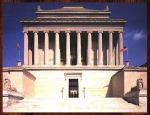 |
|
Figure 8
House of the Temple, Washington D.C. |
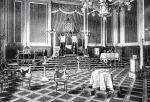 |
|
Figure 9
Scottish Rite Hall, Masonic Temple, San Francisco (Brockman: 39 |
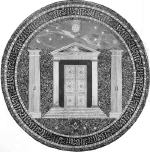 |
|
Figure 10
Lodge with the Pillars Jachim and Boaz (MacNutly: 62) |
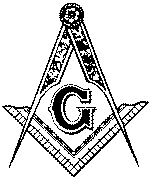 |
|
Figure 11
Mason Square |
[37] A complete analysis of all the various symbols
- not to mention all the levels of interpretation and hidden meaning - in Pike's
system would require a study at least as massive as the Morals and Dogma
itself. Let it suffice here simply to mention a few of the more important
symbols. The Lodge itself (figures 8 and 9) is a great Temple full of symbols,
patterned after the Temple of Solomon, which mirrors the great cosmic Temple of
God's universe; its two main pillars, called by the biblical names Jachim and
Boaz (figure 10), symbolize the primordial opposition of the positive and
negative forces of creation - male and female, light and darkness, sun and moon,
heaven and earth. For "every lodge is a temple, and as a whole symbolic. . . .
The arrangement of the Temple of Solomon, the symbolic ornaments which formed
its decorations, all had referents to the Order of the universe" (Pike 1871: 7).
Constructed of four hierarchical levels, the Lodge is then correlated with the
initial Masonic grades (the blue Grades of Tyler, Warden, Master, and the
Divinity above them), with the four dimensions of the cosmos (the physical,
psychic, heavenly, and divine worlds). As one ascends each of the initiations,
the secret symbols of the Masonic tradition are revealed in a progressive and
hierarchical order. At each grade, a new set of secrets is entrusted to him, and
it is largely the possession of this valued information - this cultural capital
- which defines the Mason's place within the hierarchy. In the first degree of
Apprentice, for example, the initiate is instructed in the meanings of the
Gavel, the Chisel, and the 24 inch Gauge, which represent the faculties of
passion, analysis, and measured choice; in the second degree, he is taught the
significance of the level, plumbline, and square (figure 11), which symbolize
respectively the standards of justice, mercy, and truth; finally, in the third
degree, he is taught the inner meaning of the compass, pencil, and skirrett,
representing his capacity for creativity, understanding, and balanced judgment.
Beyond these initial, rudimentary symbols, as one passes into the esoteric
grades of the Scottish Rite, the symbols multiply profusely. From his eclectic
readings of the world's sacred texts, Pike conceives an elaborate symbolic
tapestry, woven not only from the imagery of the Craft, but also from
alchemical, Kabbalistic and Templar lore (see Blanchard; Naudon: 235-36).
[38] Yet even though he devotes hundreds of pages to
elaborating their meaning, Pike repeatedly warns that the secret symbols of the
Lodge can never be reduced to a final interpretation. Indeed, their power lies
precisely in the fact that they transcend the limits of ordinary human thought.
These are secrets which "no language ever spoken by man has words to express."
Ultimately, the content of the symbols is not the most important
factor: what is important is the effect of the symbols on the initiate,
their affective power in generating awe, mystery and the sense of the
hidden power of the Masonic tradition. For "even if members failed to comprehend
the nuances of the rituals, the symbols evoked an appropriate feeling"
(Pike 1871: 22; cf. Carnes 1989: 35). As I would argue, what is important about
secrets is not primarily the occult knowledge they profess to contain, but
rather, the ways in which secrets are exchanged, the mechanisms of power
through which they are conferred, and above all, the kind of status and
"symbolic capital," which the possession of secret information bestows upon the
individual. The content is not, of course, entirely arbitrary or
meaningless, but its importance is secondary to its function as a source of
symbolic power. Pike himself seems to say as much when he describes the awesome
power of the "Grand Arcanum" - a secret so profound it cannot be expressed in
any form, a secret so dangerous it would destroy those who reveal it, a secret
so precious because it is the source of both knowledge and power:
[T]he Grand Arcanum [is] that secret whose revelation would
overturn Earth and Heaven. Let no one expect us to give them its explanation! He
who passes behind the veil that hides this mystery understands that it is in its
very nature inexplicable, and that it is death to those who win it by surprise
as well as to him who reveals it. This secret is the Royalty of the Sages, the
Crown of the Initiate (1871: 101).
[39] Not only are the numbers of symbols unlimited,
but the levels of interpretation, which become progressively more mysterious,
are equally endless. At each grade of initiation, in fact, the previous truths
of the earlier grades are stripped away, shown to be limited, relative,
teachings for the immature, while the deeper truth lies beyond. Pursuit of
knowledge becomes like peeling the layers of an onion, or exploring a set of
Chinese boxes: information on one level is the deceitful cover that creates
another kind of truth at a deeper level (see Barth: 82). The truth, Pike
suggests, is so easily profaned that it must be intentionally obfuscated or
concealed from low-level initiates, and reserved solely for the better prepared
adepts.
The Blue Degrees are but the outer court of the Temple. Part of
the symbols are displayed to the initiate, but he is intentionally misled by
false interpretations. It is not intended that he shall understand them, but
that he shall imagine he understands them. Their true explication it reserved
for the Adepts (1871: 819; my emphasis).
Indeed, even at the penultimate, thirty-second grade of the Sublime Secret,
the candidate is not actually told the deepest, innermost meaning of Masonic
symbols; rather, he is instructed that many symbols had still deeper meanings
and ties to ancient mysteries, but that he had "succeeded in obtaining but a few
hints" and could "communicate no more to you" (Blanchard: 438).
[40] In short, this system of progressive unveiling,
this peeling of the layers of secrecy, insures that the power and symbolic value
of the secret as a precious commodity always remains in tact. It remains a
source of mystery and a scarce resource, precisely because the Mason can never
know its final meaning, but must continue ascending grades of initiation, ever
uncovering deeper levels of truth. "Symbolism tended continually to become more
complicated; all the powers of Heaven were reproduced on earth, until a web of
fiction and allegory was woven . . . which the wit of man . . . will never
unravel" (Pike 1871: 63). Hence esoteric knowledge always remains a
valuable commodity, and, like all capital, the symbolic capital produced by
the possession of this commodity continues to grow and reproduce as one ascends
in rank and status.
Initiation, Hierarchy, and Status: Ascending Grades of Secrecy and Power
The fact that a man was connected with the Institution ought to
be a passport into any respectable society (The Trestleboard, 11 [May
1897]: 213-14).
Among men, some govern, others serve, capital commands and
labor obeys, and one race, superior in intellect, avails itself of the strong
muscles of another that is inferior (Pike 1871: 829)
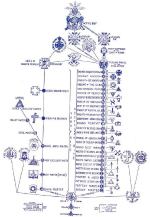 |
|
Figure 12
Various Organizations and Degrees that Comprise Freemasonry (Brockman: 14) |
 |
|
Figure 13
Initiatory Death (MacNulty: 81) |
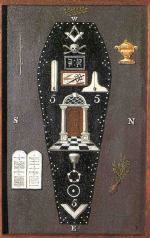 |
|
Figure 14
Third Degree Tracing Board (MacNulty: 49) |
[41] The third strategy I wish to examine is the
construction of an initiatic hierarchy, a graded structure of ranks, which the
Mason ascends as he rises in esoteric knowledge. By being initiated into the
Masonic secrets, the novice gains a new identity, which is inscribed as a
subordinate limb within the hierarchical body of the Lodge ("Power in our Rite
descends from the summit," as Pike put it [Letter March 11, 1866, in W.
Brown 1997: 423]). Yet at the same time, this hierarchy also becomes a "ladder
of symbolic capital," a means to upward mobility which confers increasing status
and power upon the Mason (see Moore: 31-32; Clawson 1996: 53-54).
[42] The Scottish Rite is the most elaborate and
complex of all Masonic traditions. Whereas most Masonic orders have just three
grades - the Blue grades of Apprentice, Fellow, and Master - the Scottish Rite
adds an additional thirty, increasingly more mysterious levels of initiation
(figure 12). The first three grades, as we have seen above, contain the more
basic teachings of morality, loyalty, and obedience, as the novice is taught the
meaning of key Masonic symbols and the symbolism of architecture. The third
level of Master involves the important initiatory process of death and rebirth
(figures 13 and 14), whereby the Mason dies to his old identity in the exoteric
world and is reborn into a new identity within the Lodge. The brothers reenact
the legendary narrative of Hiram Abiff - the architect who knew the secret of
Solomon's temple and was killed by assassins for the sake of his knowledge. In
the process, the initiate himself undergoes a symbolic death and rebirth, now
grafted as a limb onto the greater hierarchical body of the Lodge (see
Blanchard: 438ff).
[43] Once he passes beyond the first three lower
grades, having undergone this death and rebirth into a new identity, the Mason
enters into the more elaborate hierarchy of the thirty higher grades. These more
secret initiations are conceived on the model of an intricate architectonic
structure, a great pyramid of increasingly prestigious ranks. We need not
analyze all thirty of these here - which begin with the grade of Secret Master
and extend to the highest, most powerful grades of Grand Inspector, Inquisitor
Commander, the Sublime Prince of the Royal Secret, and Sovereign Grand
Commander. What is important to note is, first, that these progressively
esoteric grades create a complex "map" or structural model of the ideal social
order, an order based on ever more esoteric degrees of knowledge, and ever
increasing levels of status (Moore: 31ff). At the grade of the Sublime Secret,
for example, the Commander leads the candidate to the west end of the lodge,
where a series of complex geometric figures are drawn upon the floor. First,
there is a nonagon, around which the other members stand, which is said to be
"symbolic of an encampment of the Masonic army." Having been informed that he
will now learn the most esoteric meaning of the order, the candidate then
circumambulates the nonagon twice. The figure is surrounded by a series of nine
flags, and at each flag, the Commander explains the meaning of the first
eighteen grades. He then reveals to the candidate a drawing of a nonagon, within
which are inscribed several smaller geometric figures - a septagon, which
symbolizes the nineteenth through twenty-fifth degrees; a pentagon which refers
to the twenty-sixth through thirtieth degrees, and within the pentagon there is
a triangle, then a circle and finally, at the very center of it all, a single
point. These last three figures refer to the three highest Masonic grades - the
Grand Inquisitor Commander, the Sublime Prince of the Royal Secret, and finally
at the center of all, the Sovereign Grand Commander. In this way, the entire
hierarchy of the Lodge is imaginatively constructed as a great pyramid or a
series of concentric geometric figures, mirroring the architectonic structure of
God's universe. Just as the entire cosmos ascends as a hierarchical structure,
rising from its base in the material world to the supreme point of Divine Unity,
so too, the Lodge ascends from its base in the common mass of mankind all the
way to the most elite, most sublime point of unity, the Sovereign Grand
Commander (Pike 1871: 7-8, cited above).
[44] As Bourdieu, Lincoln, and others point out,
symbolic maps and hierarchical schemas like this are very often also maps of
social space: they provide structural blueprints of a particular social and
political arrangement, making that arrangement appear to be "natural," as if
inscribed into the very structure of creation by the hand of the Divine
Architect. In short, "symbolic space (e.g. house, temple, ) is model of social
space (social, economic, and political hierarchies)" (Bourdieu 1977a: 89). In
fact, these kinds of symbolic hierarchies often serve to mask and recode social
hierarchies, making them appear "legitimate": by creating homologies and secret
correspondences between social, cosmic, and psycho-physical levels of existence,
they "provide an ideological mystification for sociopolitical realities," such
that "arbitrary social hierarchies are represented as if given by nature"
(Lincoln: 139-41).
[45] Finally and most importantly, however,
the elaborate grades of this initiatic hierarchy serve not only to create a kind
of social map, they also create a ladder of symbolic capital, a means to
achieving new status, power, and prestige within the Masonic community. As
Dumenil suggests, one of the primary reasons for the enormous popularity of the
Lodge in late nineteenth century America was that it offered young men a
powerful source of status and distinction: By creating an "elite group offering
prestige by advancements through the degrees," it served to "confer status on a
small number" and also offered a means to "financial aid, business and political
connections, and sociability."
[F]raternal orders provide average men with avenues for
achieving distinction. One major vehicle for attaining prestige within masonry
was office-holding. Masonry had a complex system of government staffed by
numerous officials. . . . [A] Mason would progress through the offices of
Steward, Junior Deacon, Senior Deacon, Junior Warden, and Senior Warden to
become Master (14; cf. Clawson 1996: 52).
As such, Carnes suggests, the elaborate ranks and promotions in the Scottish
Rite were especially attractive to socially ambitious men during an era of rapid
economic change:
Preoccupied with issues of status in a changing society, these
ambitious and politically active men did not intend to throw the doors of the
lodges open to all comers, but conceived of the order as a means of validating
their own attainments (1987: 22-23).
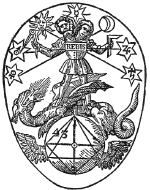 |
|
Figure 15
Rebis or Androgyne (Pike 1871: frontpiece, chap. 32) |
[46] Ultimately, at the highest level of initiation,
the Mason comes to learn the most profound, most secret essence of the
Brotherhood, which is at the same time the most prestigious of achievements:
this is embodied in what Pike cryptically calls the "Mystery of Balance" or
coincidence of opposites. Pike takes this mystery from the traditions of alchemy
and Kabbalah, and, in fact, the frontispiece of chapter thirty-two of Morals
and Dogma is a famous alchemical engraving of the Rebis or Androgyne (figure
15), borrowed from Basil Valentine. This is what the Kabbalist treatise, the
Zohar, describes as the secret of universal equilibrium between good and evil,
light and darkness. All contraries emanate from a single God. Male and female,
sun and moon, light and dark - symbolized by the Masonic compass and square, and
by the two pillars Jachim and Boaz - all come from the same source, and all
re-unite in the highest initiation. Pike believes that this most profound
mystery can be discovered by using the Kabbalistic technique of letter
combination, by taking apart and reforming the letters of the tetragrammaton,
the holy Name of God, YHWH. If the tetragrammaton is divided and read backwards,
it produces the word HO-HI. In Hebrew HO is the masculine pronoun, HI the
feminine. The reordered tetragrammaton is then translated as HE-SHE, which Pike
believes to be a confirmation that God is, in his ultimate essence, the bisexual
coincidence of opposites:
Reversing the letters of the Ineffable Name, and dividing it,
it becomes bi-sexual, as the word Yud-He or Jah and discloses the meaning of the
obscure language of the Kabbalah. . . . God created man as male and female (Pike
1871: 849).
[47] Carnes would like to give this esoteric
teaching a kind of psychological/gender interpretation: it affirms, he suggests,
the secret fact that men too have a feminine side, something which few Victorian
American males could admit publicly (1989: 149-50). However, I would argue for a
more social and political interpretation. Pike himself suggests that the true
meaning of this union of opposites is really the harmonious wedding of
individual freedom with hierarchical authority, the wedding of self-will with
obedience to law, which is the basis of the ideal social order. It is the
subordination of individual appetite - the human in us - to Reason and Moral
Judgment - the Divine in us, which is embodied in the Lodge. This hierarchical
union is the foundation of Freemasonry and the means to achieving the true "Holy
Empire," of which the Lodge is the model and prefiguration: "FREEMASONRY is
the subjugation of the Human that is in man by the Divine. . . . That
victory . . . is the true HOLY EMPIRE. Such is the true Royal Secret, which
makes possible, and shall at length make real, the HOLY EMPIRE of Masonic
Brotherhood" (Pike 1871: 855, 861). On the social and political level, this is
the union of individual free will and obedience to hierarchical power, which is
the foundation of the ideal Society and the truly just Government:
[T]he Equilibrium between Authority and individual action
constitutes Free Government by settling on . . . liberty with obedience to law,
equality with subjection to authority, Fraternity with subordination to the
Wisest and the Best (Pike 1871: 827).
[48] Here we find the final resolution of the deep
tension running throughout the American Masonic tradition - namely the emphasis
on freedom, equality, and individual sovereignty, on one hand, and elitism,
hierarchy, and subordination to higher authority, on the other. On one hand,
this supreme degree represents a powerful affirmation of the ultimate
sovereignty and freedom of the individual conscience. "We respect the creeds of
all men, because God alone is the supreme judge of his children. Each of our
Brethren has the right to . . . worship according to the dictates of his own
conscience" (Pike, in Whalen: 65). But at the same time, even while it affirms
individual freedom, it also reinforces a hierarchy of power based on reverence
for rank and the pursuit of status - the so-called "meritocracy" we have
analyzed above.
[49] Ultimately, Pike suggests, this is none other
than the natural law at work in all of creation, the subordination of the lesser
to the greater, the weak to the strong, the poor to the wealthy, which has been
ordained by God in nature and in the just society. Class hierarchies, labor
relations, even racial domination and slavery - all of these are
established by the will of God, and it is the duty of the true Mason freely to
obey them. As Pike explains in one particularly shocking and, to a contemporary
reader, quite offensive, passage:
The law of Justice is as universal as the law of Attraction. .
. . Among bees, one rules while the other obeys, some work while others are
idle. . . . The lion devours the antelope that has as good a right to life as
he. Among men, some govern, others serve, capital commands and labor obeys, and
one race, superior in intellect, avails itself of the strong muscles of
another that is inferior; and yet, no one impeaches the Justice of God. . .
. It is easy for some dreaming theorist to say that it is unjust for the lion to
devour the deer... but we know no other way . . . in which the lion could live .
. . [God's] justice does not require us to relieve the hardship of millions
of all labor, to emancipate the slave, unfitted to be free, from all
control (1871: 829; my emphasis).
Thus the secret truth of the highest degree is also the secret to reconciling
the ideals of freedom and equality with the desire for symbolic capital; it
offers a means of harmonizing democracy with the pursuit of status in an
asymmetrical hierarchy of ranks and degrees, based on a clear ideology of
exclusivism, classism, and racism.
Conclusions and Comparative Comments
The vagueness of symbolism, capable of many interpretations,
reached what the . . . conventional creed could not. Its indefiniteness
acknowledged the abstruseness of the subject; it treated the mysteries
mystically (Pike 1871: 22).
[50] By the second quarter of the twentieth century,
the Lodges appear to have lost much of the dominant role they had played in late
nineteenth century America. According to some like Dumenil, this was due to the
increasingly secular character of modern American culture, which made the
religious aspects of the rituals appear to be outdated and archaic. "The somber
religious tone of its ceremonies placed Masonry out of step with modern times"
(163). Others suggest that the economic functions of the Lodge, as a site of
business connections and financial relations, were rendered obsolete amidst the
increasingly complex structures of industrial capitalism. And still others like
Carnes point to changing conceptions of manhood, suggesting that young men in
twentieth century America shared fewer of their fathers' anxieties about
masculinity, and so no longer needed the elaborate patriarchal ritual of the
Lodges (1989: 154ff).
[51] Yet, whatever may be the reasons for its
gradual decline in this century, the American Lodge did for a time provide a
kind of oasis, an ideal realm in which white, upper and middle class values
could be reinforced. For men like Albert Pike, the secret symbols and
hierarchical initiations offered a means of acquiring status amidst an
increasingly heterogeneous world. But more importantly, the layers of secrecy
also served to re-code and legitimate that status, making it appear to be based
on merit, character, and moral goodness.
[52] Finally, I would also like to suggest that this
alternative approach to secrecy and this model of "adornment" could also have
much broader comparative implications for the study of esoteric traditions
cross-culturally. As I have argued here, secrecy is a strategy which may be
deployed for a wide range of interests; like all discourse, it may be used both
to support and reinforce, or to subvert and undermine, a given social or
political arrangement. It may, for example, be used by dominant elite factions
who wish to reinforce their own power and status within the social hierarchy
(e.g. Jewish Kabbalah, Sufi orders such as the Chishtiya, the hierarchy of
elders among the Australian Aborigines [see Urban 1997; Scholem; Keen]); and it
may equally be used by marginalized, disgruntled, deviant, or revolutionary
groups (e.g. Haitian Voodoo, the Mau Mau in Kenya, the White Lotus or Triad
societies in China [see K. Brown; Roseberg and Nottingham]). Now, the specific
content of the secrecy in all of these various esoteric traditions will
no doubt be radically different and determined by their particular historical,
political, and social contexts. However, my suspicion is that the forms and
strategies through which secrecy operates - such as the creation of an
alternative social space, the use of deliberately ambiguous and obfuscating
symbolism, the rhetoric of egalitarianism, and the construction of elaborate new
hierarchies of power - may well turn out to be strikingly similar across
cultures and throughout historical periods.
back to top |
![]()




















